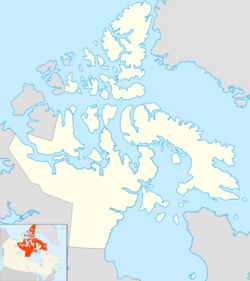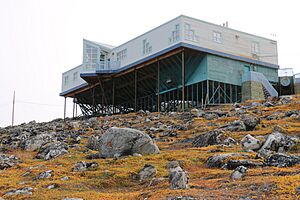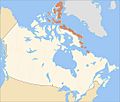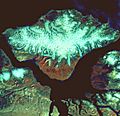Pond Inlet facts for kids
Quick facts for kids
Pond Inlet
Mittimatalik
ᒥᑦᑎᒪᑕᓕᒃ |
|
|---|---|
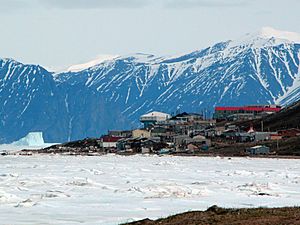
Pond Inlet in mid-June 2005 from Salmon Creek, 3.5 km (2.2 mi) west of the hamlet
|
|
| Country | Canada |
| Territory | Nunavut |
| Region | Qikiqtaaluk |
| Electoral district | Tununiq |
| Government | |
| • Type | Hamlet Council |
| Area
(2021)
|
|
| • Total | 170.83 km2 (65.96 sq mi) |
| Elevation | 55 m (180 ft) |
| Population
(2021)
|
|
| • Total | 1,555 |
| • Density | 9.1/km2 (24/sq mi) |
| Time zone | UTC−05:00 (EST) |
| • Summer (DST) | UTC−04:00 (EDT) |
| Canadian Postal code |
X0A 0S0
|
| Area code(s) | 867 |
| Website | www.pondinlet.ca |
Pond Inlet (Inuktitut: Mittimatalik, lit. 'the place where Mittima is buried') is a small community in Nunavut, Canada. It is mostly home to Inuit people. You can find it on the northern part of Baffin Island. The Inuit name for the place is "Mittimatalik," which means "the place where the landing place is."
A Scottish explorer, Sir John Ross, named the nearby bay "Pond's Bay" in 1818. This was to honor an English astronomer named John Pond. Later, in 1921, the Hudson's Bay Company opened a trading post here. They called it Pond Inlet, and the community still uses that name today.
Pond Inlet is the biggest community in northern Baffin Island. It's part of the Arctic Cordillera, a region with mountains all around. People call it the "Jewel of the North" because it's so beautiful. Many visitors come here each year by plane or cruise ship.
Contents
Exploring Pond Inlet's Location
Pond Inlet, or Mittimatalik, is located at the northern tip of Baffin Island. It sits on the east side of Eclipse Sound, near the Lancaster Sound region.
The area has a very cold climate. Winters are long and dark, with temperatures often around −35 °C (−31 °F). Pond Inlet is one of the main communities in the Arctic Cordillera.
Wildlife Near the Ice Edge
A special feature near Pond Inlet is its ice edge. This is where the open water meets the sea ice. Many animals gather here because it's easier to find food. You can see ringed seals, Arctic cod, murres, and other seabirds.
Bylot Island: A Natural Wonder
About 30 km (19 mi) from Pond Inlet is Bylot Island. This large island is mostly uninhabited and is a protected area. The waters between Bylot Island and Baffin Island are called Navy Board Inlet and Tasiujaq. Navy Board Inlet is also an entrance to the famous Northwest Passage.
Bylot Island is part of Sirmilik National Park. It's also home to the Bylot Island Migratory Bird Sanctuary. This sanctuary protects nesting grounds for many birds, like thick-billed murres, black-legged kittiwakes, and greater snow goose.
Inuit from Pond Inlet often visit Bylot Island. Its mountains create a stunning view from the community.
Ancient History and Place Names
Archaeologists have found old sites on Bylot Island. These include Thule sod houses, used by the ancestors of today's Inuit. These sites show that people have lived and hunted in this area for centuries.
The Inuit in Pond Inlet have names for about 150 local places. These names describe the land and water features. For example, a sound west of the hamlet is called Tursukattak. This means "heading west from a narrow passage to a large opening," like the entrance to an igloo.
People of Pond Inlet
| Federal census population history of Pond Inlet | ||
|---|---|---|
| Year | Pop. | ±% |
| 1976 | 504 | — |
| 1981 | 705 | +39.9% |
| 1986 | 796 | +12.9% |
| 1991 | 974 | +22.4% |
| 1996 | 1,154 | +18.5% |
| 2001 | 1,220 | +5.7% |
| 2006 | 1,315 | +7.8% |
| 2011 | 1,549 | +17.8% |
| 2016 | 1,617 | +4.4% |
| 2021 | 1,555 | −3.8% |
| Source: Statistics Canada |
||
In 2021, the population of Pond Inlet was 1,555 people. Most of the people living here are Indigenous, mainly Inuit.
Pond Inlet has a younger population compared to the rest of Canada. About 36.7% of the people are under 15 years old. The average age in Pond Inlet is 26.6.
Historical Roots of the Community
The people of the Pond Inlet region are known as Tununirmiut or Mittimatalingmiut. For thousands of years, people have lived here, hunting and fishing on land, sea, and ice.
Many Inuit in Pond Inlet today are related to families from Igloolik. These groups were semi-nomadic in the past. They traveled long distances by foot and dog sled to follow caribou and sea mammals.
In the early 1900s, non-Inuit traders and whalers came to the area. Later, the Hudson's Bay Company, Anglican and Catholic missions, and the Royal Canadian Mounted Police set up posts.
Cultural Heritage and Art
The area around Pond Inlet has a rich cultural history. Ancient Dorset people created amazing masks, some of which are now in the Canadian Museum of History.
In the 1960s, an art project collected drawings from Inuit artists in Pond Inlet and other northern communities. These drawings show what life was like during a time of big changes.
Education and Residential Schools
Starting in the 1960s, some Inuit youth from Pond Inlet were sent to the Churchill Vocational School in Manitoba. This was part of the Canadian Indian residential school system. These schools aimed to teach academic and job skills. However, they also separated children from their families and culture. The Truth and Reconciliation Commission of Canada later studied the impact of these schools.
Today, Pond Inlet has local schools for students from kindergarten to grade 12. Nunavut Arctic College also offers programs for adults.
Wildlife and Traditional Life
Many Inuit in Pond Inlet still live off the land. This means they rely on hunting, fishing, and trapping. The wildlife in the area is very important for their traditional way of life.
You can find many animals here, including caribou, polar bears, Arctic foxes, ermines, lemmings, and Arctic hares. In the coastal waters, there are walrus, seals, beluga whales, and narwhals. Ringed seals are a very important part of the traditional diet.
Mittimatalik Hunters and Trappers Organization
The Mittimatalik Hunters and Trappers Organization (MHTO) in Pond Inlet helps protect Inuit hunting rights and traditional ways of life. They speak up about how big projects, like mines, might affect the environment and wildlife. They want to make sure that Inuit interests are heard and respected.
Economy and Tourism
Pond Inlet has a mixed economy. People work in jobs that pay wages, but they also continue traditional activities like hunting and fishing. These traditional activities are very important for Inuit culture and the local economy.
The government is the biggest employer in Pond Inlet. There are also small businesses, tourism, and arts and crafts.
Pond Inlet: A Tourist Destination
Pond Inlet is known as one of Canada's "Jewels of the North" for tourists. It's a very scenic place with mountains everywhere. You can often see icebergs close to the community. The area also has glaciers, ice caves, and beautiful inlets.
Visitors can see amazing wildlife like Barren-ground caribou, ringed seals, narwhals, and polar bears. Sirmilik National Park, known for its glaciers, is also nearby.
The Nattinnak Visitor Centre is a popular spot for tourists. It offers walking tours, visits to ancient Thule sites, and cultural performances. This helps local artists and performers. The centre also shares a building with the Rebecca P. Idlout Public Library, which is named after a local educator.
Local Businesses and Services
The Tununiq Sauniq Co-operative is a local business that provides many services. It runs a retail store, a hotel, and offers fuel delivery. It also manages services like school buses, airline agents, and equipment rentals. The Co-op helps deliver goods and services to the people of Pond Inlet.
Transportation and Communication
Pond Inlet is usually reached by plane, with flights connecting through Iqaluit, Nunavut's capital. When the ocean is free of ice, usually for a few months, cruise ships bring tourists, and cargo ships deliver supplies. Fresh food like fruits and vegetables are flown in several times a week from places like Montreal, which is about 3,000 km (1,900 mi) away.
Because of the long distances, food and building materials can be much more expensive than in southern Canada.
Within the community, snowmobiles and ATV four-wheelers are the main ways to get around.
Broadband Communications
Pond Inlet has internet service through the Qiniq network. This service connects homes and businesses using satellites. In 2017, the network was updated to faster 4G LTE technology.
Climate in Pond Inlet
Pond Inlet has a polar arctic climate. This means it has very long, cold winters and short, cool summers. The average high temperature for the year is −11.1 °C (12.0 °F), and the average low is −18.0 °C (−0.4 °F). The coldest month is February, with an average daily temperature of −34.7 °C (−30.5 °F). The warmest month is July, with an average of 6.6 °C (43.9 °F).
| Climate data for Pond Inlet (Pond Inlet Airport) WMO ID: 71095; coordinates 72°41′22″N 77°58′08″W / 72.68944°N 77.96889°W; elevation: 61.6 m (202 ft); 1981–2010 normals |
|||||||||||||
|---|---|---|---|---|---|---|---|---|---|---|---|---|---|
| Month | Jan | Feb | Mar | Apr | May | Jun | Jul | Aug | Sep | Oct | Nov | Dec | Year |
| Record high humidex | 3.6 | −4.0 | −0.8 | 3.9 | 9.4 | 15.0 | 22.0 | 18.9 | 11.8 | 6.0 | 1.2 | −0.5 | 22.0 |
| Record high °C (°F) | 3.7 (38.7) |
−3.3 (26.1) |
0.0 (32.0) |
3.9 (39.0) |
12.1 (53.8) |
15.5 (59.9) |
22.0 (71.6) |
19.0 (66.2) |
11.9 (53.4) |
6.5 (43.7) |
2.0 (35.6) |
−1.0 (30.2) |
22.0 (71.6) |
| Mean daily maximum °C (°F) | −30.0 (−22.0) |
−30.2 (−22.4) |
−26.2 (−15.2) |
−17.6 (0.3) |
−5.3 (22.5) |
5.2 (41.4) |
10.5 (50.9) |
7.8 (46.0) |
1.8 (35.2) |
−6.4 (20.5) |
−17.8 (0.0) |
−24.5 (−12.1) |
−11.1 (12.0) |
| Daily mean °C (°F) | −33.4 (−28.1) |
−33.7 (−28.7) |
−30.0 (−22.0) |
−21.9 (−7.4) |
−9.3 (15.3) |
2.4 (36.3) |
6.6 (43.9) |
4.8 (40.6) |
−0.8 (30.6) |
−9.7 (14.5) |
−21.7 (−7.1) |
−28.2 (−18.8) |
−14.6 (5.7) |
| Mean daily minimum °C (°F) | −36.7 (−34.1) |
−37.1 (−34.8) |
−33.6 (−28.5) |
−26.1 (−15.0) |
−13.2 (8.2) |
−0.6 (30.9) |
2.7 (36.9) |
1.7 (35.1) |
−3.4 (25.9) |
−12.9 (8.8) |
−25.2 (−13.4) |
−31.8 (−25.2) |
−18.0 (−0.4) |
| Record low °C (°F) | −49.8 (−57.6) |
−53.9 (−65.0) |
−49.0 (−56.2) |
−40.2 (−40.4) |
−28.4 (−19.1) |
−14.0 (6.8) |
−6.1 (21.0) |
−6.1 (21.0) |
−16.4 (2.5) |
−30.1 (−22.2) |
−42.0 (−43.6) |
−45.5 (−49.9) |
−53.9 (−65.0) |
| Record low wind chill | −64.8 | −68.5 | −60.3 | −51.4 | −36.2 | −20.7 | −6.7 | −17.8 | −25.0 | −42.0 | −51.6 | −58.6 | −68.5 |
| Average precipitation mm (inches) | 4.8 (0.19) |
3.8 (0.15) |
6.6 (0.26) |
10.5 (0.41) |
9.4 (0.37) |
15.6 (0.61) |
32.0 (1.26) |
38.8 (1.53) |
19.9 (0.78) |
25.1 (0.99) |
13.7 (0.54) |
8.9 (0.35) |
189.0 (7.44) |
| Average rainfall mm (inches) | 0.0 (0.0) |
0.0 (0.0) |
0.0 (0.0) |
0.0 (0.0) |
0.0 (0.0) |
12.1 (0.48) |
31.5 (1.24) |
35.9 (1.41) |
9.8 (0.39) |
1.3 (0.05) |
0.4 (0.02) |
0.0 (0.0) |
91.0 (3.58) |
| Average snowfall cm (inches) | 5.8 (2.3) |
5.0 (2.0) |
8.6 (3.4) |
12.7 (5.0) |
14.3 (5.6) |
4.4 (1.7) |
0.4 (0.2) |
2.8 (1.1) |
13.7 (5.4) |
33.8 (13.3) |
17.9 (7.0) |
12.6 (5.0) |
131.9 (51.9) |
| Average precipitation days (≥ 0.2 mm) | 4.6 | 4.1 | 6.5 | 6.2 | 6.2 | 5.9 | 8.0 | 9.9 | 7.9 | 11.7 | 8.2 | 7.4 | 86.7 |
| Average rainy days (≥ 0.2 mm) | 0.0 | 0.0 | 0.0 | 0.0 | 0.0 | 4.4 | 7.9 | 9.2 | 2.8 | 0.2 | 0.0 | 0.0 | 24.5 |
| Average snowy days (≥ 0.2 cm) | 4.6 | 4.2 | 6.6 | 6.1 | 6.2 | 2.1 | 0.2 | 1.0 | 5.3 | 11.5 | 8.2 | 7.4 | 63.3 |
| Average relative humidity (%) | 65.3 | 65.3 | 65.0 | 70.4 | 78.1 | 75.8 | 71.6 | 75.1 | 77.0 | 80.3 | 72.5 | 67.6 | 72.0 |
| Mean monthly sunshine hours | 0.0 | 0.0 | 177.0 | 301.7 | 353.7 | 330.4 | 359.6 | 192.1 | 90.2 | 39.3 | 0.0 | 0.0 | 1,844 |
| Percent possible sunshine | 0.0 | 0.0 | 49.5 | 59.0 | 48.4 | 45.9 | 48.3 | 30.7 | 21.9 | 15.0 | 0.0 | 0.0 | 39.8 |
| Source: Environment and Climate Change Canada Canadian Climate Normals 1981–2010 | |||||||||||||
Mineral Development and Environmental Concerns
There have been large mining projects near Pond Inlet. One example is the Mary River Mine, an open-pit iron ore mine. It started operating in 2014 and is located about 160 km (99 mi) south of Pond Inlet.
These mining projects have led to discussions about their impact on the environment and Inuit culture. Local groups, like the Mittimatalik Hunters and Trappers Organization, have raised concerns about how the mine might affect wildlife, like caribou, seals, and narwhals. They also worry about dust from the mine's roads affecting the land and water.
The Nunavut Impact Review Board assesses these projects. Even countries like the Kingdom of Denmark have shown concern because the shipping routes for the iron ore pass near Greenland, which is an autonomous territory of Denmark.
Notable People from Pond Inlet
- Siku Allooloo: A writer, artist, and educator with Inuit and Haitian heritage.
- Titus Allooloo: A businessman and former politician in the territory.
- Joe Enook: An Inuit politician who represented the Tununiq district.
- Elijah Erkloo: A former politician in the territory.
- Joseph Idlout: An Inuk who was featured on the Canadian two-dollar bill.
- Ruben Komangapik: An Inuit artist known for his sculptures.
- Jobie Nutarak: An Inuit politician who represented the Tununiq district.
- Karen Nutarak: An Inuit politician who represents the Tununiq district.
- Elisapee Ootoova: An Inuit elder who worked to preserve traditional Inuit knowledge.
Images for kids


